After a week in 9,350-foot high Quito I was no longer huffing and puffing as I trekked up and down the city’s ubiquitous hills, so I was totally unconcerned about altitude as I headed for the central highlands of Ecuador, home to spectacular volcanoes and some of the best hiking in the country. The dust-caked brakes of my rickety bus squealed to a halt in the center of Chugchilan, where indigenous Quichua had gathered in droves to celebrate Dia de Difuntos (Day of the Deceased). Anxious to photograph the event, I double-timed up the hill to Hostal Cloud Forest, dumped my luggage and headed back out, surprised that I was breathing heavily after such a short distance.

Though I had observed Quichua women in their distinctive bowler hats in Quito, this was my first opportunity to mingle with the indigenous population. My initial excitement quickly faded when my repeated requests to take photos were rebuffed with shakes of the head and turned backs. Crowds parted like the Red Sea as I walked down the main street and my smile was met with suspicious looks. Stone-faced vendors sold me snacks without so much as a thank you.

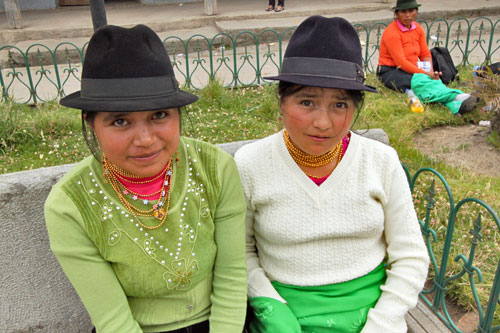
As the late afternoon light faded to twilight and temperatures dropped to bone-chilling levels, I finally convinced two beautiful young Quichua girls in the main plaza to pose for a photo before fleeing back to the warmth of the hostel’s wood-burning stove. When my shivering subsided I nosed around the facilities. The dining room was furnished with rough wooden tables and benches and a cavernous below-ground common area room held only a lone computer and three plastic lawn chairs. With no comfortable place to relax I retreated to my unheated room after a tasteless dinner, hoping to catch upon email, only to discover that the Internet was not working. I tried to write but my frigid fingers fumbled on the keyboard and when my throat grew raw from the cold I stood under a scalding hot shower and jumped under a mound of woolen blankets, hoping to ward off the sinus infection that threatened.
Early the next morning I threw open the curtains to brilliant sunshine that rapidly warmed up my room. Anxious to investigate the area, I teamed up with two backpackers from France and Australia for a trek to a cheese factory located in a tiny village, high in the surrounding mountains. The hostel owner drew a crude map on a scrap of paper and assured us the round-trip hike would take about four hours, so we headed out early in order to avoid the fog that rolls in every afternoon.
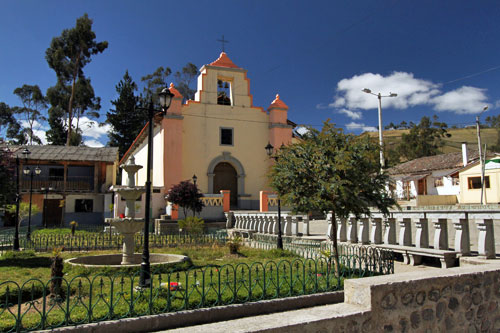
Just past the church we turned right on a dirt road that climbed steeply and within minutes I was gasping. On the pretense of oohing and aahing over a baby sheep staked to a patch of grassy hillside, I stopped to regain my breath. “How high do you thing we are?” I asked Jerome. He whipped out his altimeter. “We are almost at ze 11,000 feetz,” he declared in his delightful French accent. My brow wrinkled; this was the highest I had been so far in Ecuador. Still, I hadn’t felt any major effects in Quito so I pressed on, grateful that my two young companions were happy to let me rest every so often.
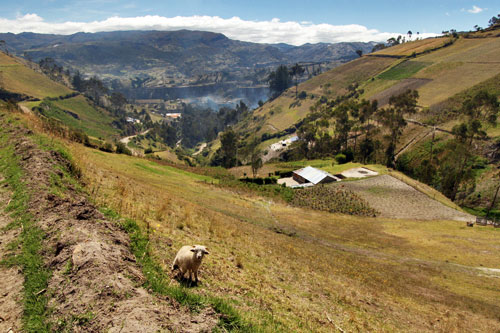
It soon became apparent that our map bore little resemblance to the actual route and we began asking locals if we were walking in the correct direction. An hour into the trek men on horseback said the factory was just a little way ahead. Soon afterward a group of children ran up the hillside and offered to be our guides for a fee; when we declined they told us the factory was just twenty minutes further up the road. Higher and higher we climbed, until snow capped peaks emerged from behind the sculpted green hills. Hoping to mask my pulmonary distress, I paused and offered tips on the best techniques for shooting photos in the mountains, but I think Jerome and Caitlin were on to my ploy. A bit further along Jerome created another excuse to rest as we sat beneath giant tussocks of grass on the side of the road and pretended to preen our long locks. I would like to believe they were as tired as me but I suspect they were just being kind.

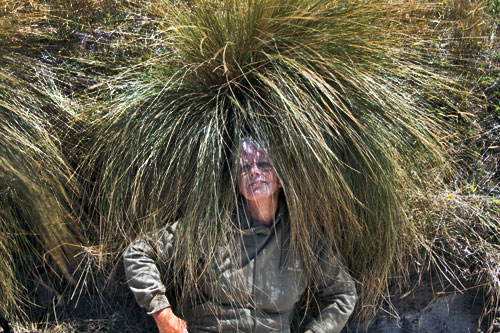
When the road finally crested at 12,000 feet I gazed over stark rounded hills covered in thigh-high grasses, amazed that anyone actually lived in such a remote place. Two and a half hours into our trip there was absolutely no sign of a village, much less a cheese factory. We descended through clouds that billowed across the road and blocked the sun, turning a warm morning into a dreary, drizzly afternoon, and finally reached a fork in the road. Our map called for a left turn but far ahead, a barely visible Quichua man and his dog had taken the right-hand path; we decided to follow him. Not long afterward tiny concrete houses that mimicked the barren hills began to appear and we soon found the turnoff to the cheese factory. Bedraggled and exhausted, I negotiated to buy some of the three varieties of cheese the owner produced, struggling to understand his mountain dialect that mixed Spanish with Kichua words.
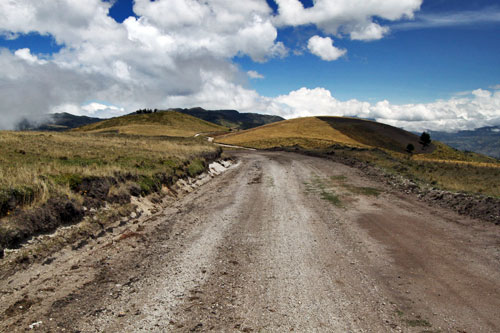
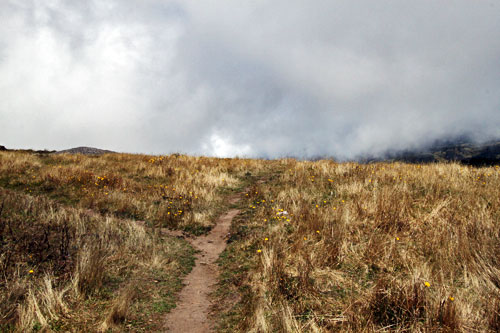
With plummeting temperatures and nothing but a sweatshirt to keep me warm I left Caitlin and Jerome and caught a ride partway down the mountain but it was too late – by the time I arrived back at the hostel I was chilled to the bone. Fully clothed, I climbed beneath the mountain of covers on my bed but still could not get warm. I turned on the shower full blast and stripped, shivering uncontrollably as I waited for hot water that never arrived. For the remainder of that long, miserable night, I tossed and turned, unable to warm my icicle feet and fingers; by morning I was willing to pay almost anything to find more comfortable accommodations. Fortunately, Hostal Mama Hilda was right next door and the owner’s daughter showed me common rooms furnished with comfy overstuffed furniture that were heated by wood stoves every evening. Best of all, she promised me a room with a portable heater. I lost no time in transferring my luggage and settled into the sun room to write.
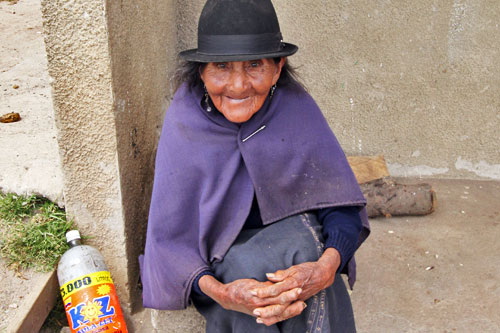
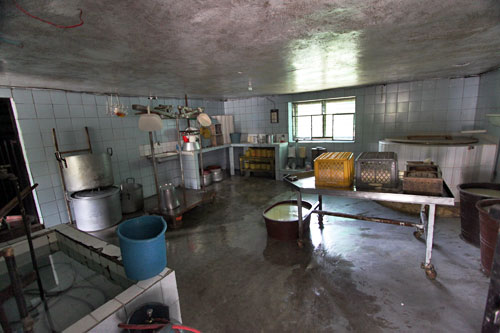
My contentment was short lived. The soothing background music that had been playing on the radio when I arrived was changed to heavy rock and a group of men gathered in the lobby to hold a community meeting, talking and arguing in loud voices for the next two hours. Trucks rumbled by outside, dogs barked incessantly, and car alarms went off every few minutes. My head throbbed, my throat was raw. By late afternoon I began to shiver again and asked if someone would light the stove but was repeatedly told it would be done “later.” After dinner I just wanted to climb into bed but my promised heater had never materialized and when I requested it I was handed a hot water bottle. I wriggled beneath the covers wearing three layers of clothes and slept fitfully for a few hours but woke at 3 a.m. with a serious case of diarrhea, upset stomach, severe dizziness, and chills, all classic symptoms of altitude sickness, also known as acute mountain sickness (AMS). For two miserable days I languished in bed, wishing I was dead. Every couple of hours I woke up gasping from the weight of the bed covers on my chest; I would throw them off until I got too cold, then burrow beneath the covers and the entire process would begin anew. There was no clinic in town and I was too sick to go down the mountain, which is the best remedy for AMS, so I just had to suffer through it. I now understand that I went up too high, too quickly after arriving; I should have taken a day to acclimate to the altitude in Chugchilan prior to hiking to the cheese factory.
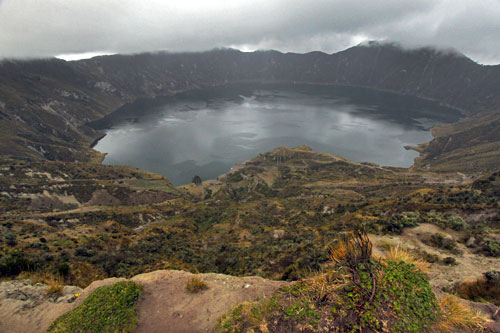
Three days later I was still too weak even to take the crowded local bus down the mountain and instead had to hire a private truck. Fortunately, my driver was kind enough to make a brief stop at the Quilotoa Caldera, the most popular site on the Quilotoa Loop. Wearily, I dragged myself up the short trail to the crater rim and snapped a photo of the collapsed volcanic cone filled with a deep blue lake. It would have been a shame to come all this way and not see the caldera, but I can honestly say that all I wanted at that moment was to come down from the mountain.

chinese medicine can also help with altitude sickness; cordyceps is one known herb-grows wild in tibet, also used there. so, if you are going for a set amount of time, you can research ahead of time and carry with you. There are formulas on the market with various remedies, and liquid oxygen supplement is also an option to carry. Regardless, altitude sickness is so difficult-uugh. Glad you made it through; your site is great!
I’ve even had altitude sickness in southern california, at 7k feet, going from sea level in 30 min. drive! Can happen anywhere!
Hi Barbara, so amazed to hear your story after visiting me and eating chocolate! Hope you are well and I continue to follow your adventures here!
Hi Jeff! So great to hear from you. I must tell you that I sampled chocolate from a well-known chocolatier in Peru but it was nowhere near as good as yours! Hope you are well and that business is thriving. Did you get your funding?
Beautifully captured story. I am glad that you seem to have recovered. AMS seems to be a very nasty disease as it sneaks up on unsuspecting people and appears to be unrelated to fitness, age or gender. I walked in Peru with a group of four and the youngest and by far the fittest struggled by half way through the walk and we had to take him to medical help. In Nepal, I’ve seen folks carried down in straw baskets clearly suffering from the effects. This is one area where SLOW TRAVEL is very much the best way to go. By the way, I did go with coca leaf tea in Peru and it did seem to help (though I have no idea if it was the power of suggestion or whether there were some curative properties).
Hi Travel Wonders: I was offered the coca tea more than once but as a recovering alcoholic/addict, I thought it best to steer away. What did help, though, was oregano tea!
Your posts, your photos and your fortitude are simply amazing to me. Hope you’re planning a trip to Austin one of these days — I’d love to meet up.
What fantastic photos! I’d absolutely love to visit Ecuador and get this up close and personal with it’s inhabitants. I like the hair makeover too!
I’m late to the game but, now that I’ve discovered your site, I’m addicted. Thanks for showing that those of us who are out of our “spring chicken” years can still trek up mountains.
You’re welcome Lane! Thanks for joining forces with us!
I haven’t been to Ecuador in maybe 30 yrs, but the time I was there left lasting impressions. What an amazing place, people, food.
Your blog is wonderful, and I plan on reading more!!
Happy New Year!
Thank you Nancy! And Happy New Year to you, too.
I was in Chugchilan about a year ago. We stayed at the local hostel and planned to climb Quilatoa. We hired a local guide for about $10 for the day and the 3 of us set off. We walked through town just as a local man anchored a bull to a giant ring embedded in the concrete. He stuck the animal in the neck to kill it and butcher. The bellowing was unbelievable. Your photos bring back vivid memories of the beautiful countryside and friendly people. We took our time getting to know them and had no problems taking photographs.
We did struggle with the last few hundred feet to the 14,000 ft summit of the crater lake, but it was well worth it. Unfortunately, the top is covered in scree. “Take one step, slide back 2,” was not the kind of progress we hoped to make. The locals recommend that you hitch a ride up in a vehicle and hike down. But this was good preparation for our climb on Cotopaxi Volcano. Maybe we will see you post something about that later? Ecuador is rugged country for sure and you were lucky to see the celebrations, even if they were not happy to see you.
Dealing with altitude sickness is not something to do alone. It’s miserable. If you go to Peru, they will offer coca leaf tea and most hotels in Cusco have oxygen tanks in the lobby.
Hi Jacquie: Thanks so much for your comment. The oxygen in the hotel lobbies is a good tip, though it was never available in any of the remote places I visited, and as a recovering alcoholic/addict (16 years clean and sober), I opted not to do the coca leaf tea, but I did find oregano tea to be very helpful when I was so sick.
I was also warned about hiking own to the lake at Quilotoa Crater due to the very steep sandy/rocky sides. Everyone I have spoken to echoes your comment about one step forward, two steps back. I think it’s just as well I was feeling so poorly or I probably would have tried it 🙂 Unfortunately, I did not have time to do Cotopaxi, however I think you will enjoy reading my upcoming story about participating in the Independence Day celebration in Alausi, Ecuador, which was a once-in-a-lifetime opportunity to interact with the indigenous Quichua.
Great post, trekking is a great way to see a country and its people.
I think you might have dodged a metaphorical bullet. It sounds like you had altitude sickness that had progressed to the pulmonary edema stage. When you are traveling far from medical care, do you carry first aid supplies optimized for the likely possibilities?
I know that your goal is cultural travel. How do you feel when the locals don’t feel like sharing regardless of how non-ethnocentric you are? Do you feel like a) an intruder?, b) annoyed? c) some combination of the above a and b, or d) none of the above? Do you find that if you stay long enough, people are more accepting?
I hope the questions aren’t off-putting? I’m genuinely curious. When I was 9-10 (I’m now closer to 60 than 50), we lived in Mexico for a year. My parents be-friended the maid and gardener who came with the house they rented. As a result, we were invited to a family wedding way out in the countryside—adobe hut, no running water, no electricity, but a large, loving group of people. Ironically, I think my mother felt like more of an outsider when we lived in a small Wiltshire town in England when my father was an exchange teacher there in 1969-70. Almost every day, at some point, my mother would be moved to comment, “It’s a different culture”. It’s just unexpected because of the common language. It may be less true now because of global telecommunications, but George Bernard Shaw was onto something when he said: “England and America are two countries separated by a common language.”
Sorry for the long comment. I’m a new reader and am enjoying your photos and narrative.
Suzanne
Philadelphia, PA, USA
My gosh Suzanne, never a need to apologize for a long comment – I love it that my readers are so engaged! I only occasionally feel like an outsider when I travel, and I think that’s mostly because I stay in each country longer than most regular tourists. The only time I stay less than a month is when I’m on a press trip and even then I usually extend beyond the scheduled days. As a result, I get to know the culture a bit; at least enough to write about it. am fond of saying that people the world over are more alike than they are different. We all want the same things: to be safe, well fed, have a roof over our heads, be loved, and provide for our children.
But just like everywhere, there are people who are uncaring and downright nasty. In the case of the hostel where I got so sick, had it not been for the daughter I don’t know how I could have made it through the experience. Her parents were totally uncaring about any of their guests. Two of the nights were very cold and they downright refused to light a fire in the common area at all on the coldest night and made only a halfhearted attempt to light one the next night (it went out 15 minutes after they lit it and they never tried to rekindle it). The next morning I got up and fund we had NO water. I discovered the old man who owns the place at the front gate, turning the water on at 7 a.m. Thank God my diarrhea was gone by then, as he apparently had turned it off (and all the exterior lights) the previous evening after most of the holiday weekend guests had left. When I spoke him about turning the water off, pointing out that his website represents that they have 24-hour hot water, he blew me off with some bizarre story about people in the town stealing his water. Later that same day he confronted me about having contracted transport to Latacunga from a competitor rather than hiring his car, telling me his service was cheaper. When I pointed outthat his PRINTED schedule of fees indicated his price was HIGHER, he rudely said “It’s your money, senora,” to which I replied, “Yes, it is, and I intend to spend it with people who are more reliable and truthful than you.”
Do I get frustrated? Sometimes, but I rarely get angry. My years of travel have taught me that becoming angry is probably the worst thing you can do. Because I’m a perpetual traveler, I have the luxury of flexibility. If I
can’t leave a place one day, I can go the next, so Ive learned to roll with the punches. As for sickness, I carry aspirin, Pepto Bismol, Imodium, and Benadryl, in a ziplock bag, anything else I need (prescription drugs) can be bought over the counter in most places I travel. I don’t worry about it – I even eat street vendor food with relish. Getting sick when you travel is always a part of the experience but I’ve been extremely fortunate in that regard and rarely get sick.
Bottom line: a smile and genuine curiosity is almost always guaranteed to open doors with locals. So glad you’re enjoying what I write and photograph! Wishing you a very Happy New Year.
When we lived in Mexico when I was 9, we were allowed to pretty much wander at will (unlike in Philly) and attended the local public school. My mother sent us off with plastic canteens of water purified with pills which tasted absolutely foul and with admonitions not to eat street food. After being dreadfully ill the first week we were there during which time we didn’t eat street food, my sisters and I ate street food everyday on our way home from school and I never got sick again for the rest of the year. One benefit of traveling as you do is that you can lose a few days to feeling “off” if it happens without “wasting” your entire vacation.
Hi again Suzanne: I absolutely agree. I was sick one time i n Mexico, years ago in Acapulco, and never again since then. I have always suspected that our bodies build up a resistance and immunity to the local parasites once infected and recovered.
Such a shame that your hike was overshadowed by the altitude sickness – I never suffered it in Ecuador but then after Quito I only went down in altitude – I hear that the local coca tea is really helpful
Oh, Barbara. You are such a trooper. My days of sleeping in hostels and waterfalls for showers are over. I have never experienced altitude sickness like you had. It sounds very painful. I’m so glad you are feeling better. Happy New Year to you. What a trip.
This was an excellent article. I like that fact that you write as a traveler, and not a tourist. Travelers are open to all kinds of experiences, good and bad, but tourists only want to to see the shiny bits of places, without really discovering anything. Thank you.
Thank you Nicole! Your comment made my day and maybe my whole year, as I try to connect with people on a local level wherever I am and consider myself a traveler rather than a tourist. I usually see the shiny bits, as you call them, but it’s the other experiences that I value the most. Have a wonderful New Year.
Beautiful. Love your posts. Thx.